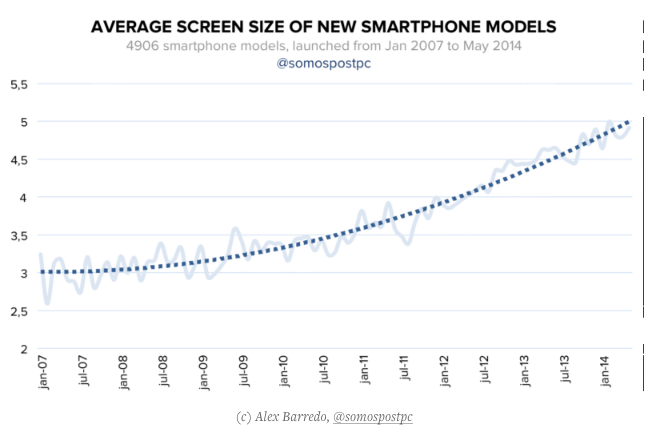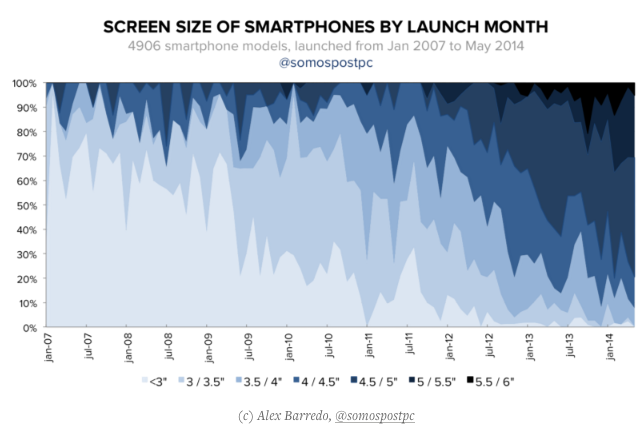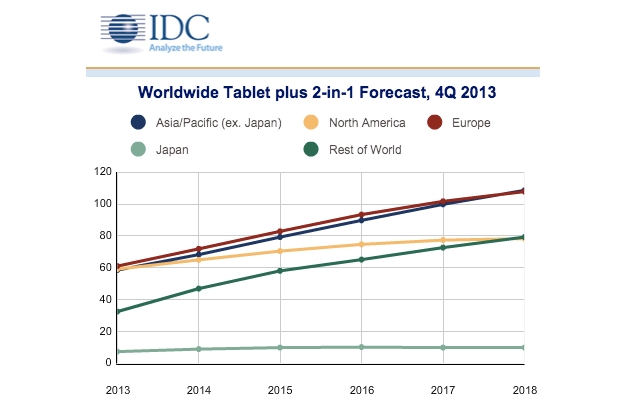
Next time you’re on the bus, streetcar or subway, or perhaps sitting down for lunch on a park bench or in a mall food court, take a look around. Specifically, notice the phones and tablets people are using.
For the most part, you’ll see three types of devices: iPhones, likely an iPhone 5 or 5s; Android phones, statistically a Samsung; and iPads. It’s quite unlikely you’ll see an Android tablet, even among those who own Android phones.
Indeed, tablet growth seems to be slowing, as highlighted by an IDC report from March that revised its initial tablet forecast for 2014. The research firm claims that, unlike 51.6% worldwide tablet growth in 2013, the same sector is likely to grow only 19.4% this year.
Year over year growth of nearly a quarter in a flourishing industry is nothing to snuff at, but when the iPad was announced in 2010 tablets were immediately hailed as the beginning of a new computer revolution. But even as they became slimmer, lighter and more powerful, it became immediately apparent that the one-screen-at-a-time paradigm would have a difficult time replacing most users’ laptops. These days, that appears more true than ever.
In an article for Re/code, former head of mobile at Netflix, Zal Bilimoria, decried that our love affair with the tablet is over. He claimed that though initial pickup of the tablet-optimized Netflix app was tremendous, usage dropped off equally quickly, replaced in kind by smartphones (and to some extent, set-top boxes). “It has been the phone all along,” he says, and activity patterns seem to reinforce this.
On the iPad side, millions of customers continue to enjoy the devices for content consumption and, increasingly, content creation. There is a whole swath of the App Store dedicated to artists, writers, brainstormers and pundits; though iPad growth has slowed, the app ecosystem continues to flourish. People may not know what the iPad is good for, but they’re making do.

Android tablets are another matter. While a March report by Gartner promises that tablets powered by Android outnumber iPads by nearly two to one, it fails to find the nuances in those astronomical numbers. The market for Android tablets is dying, murdered by its kin, the Android smartphone.

An article by Alex Barredo last month delved into the screen sizes of smartphones between 2007 and today, and while the outcome may not be hard to grok, even without looking at the graphs it paints an impressively prescient picture of Android tablets’ future.
It took five years for the average screen size to get from 3″ to 4″, but only two more to get to the current average of 5″.
Barredo finds that the average smartphone size in May 2014 was five inches, up from four inches in May 2012. Even devices dubbed “mini” are comparatively larger than their flagship equivalents two years earlier. Aside from the iPhone, which has only changed screen sizes once in its lifetime, from 3.5-inches on the original iPhone to 4-inches on the iPhone 5, Android devices have blown up.
In February 2011, when the first official Android tablets were released alongside Honeycomb, the average smartphone size was around 3.75 inches, with most high-end Android devices like the Samsung Galaxy S i9000 hovering around the 4-inch mark. It would appear that Apple was cognizant of this disparity when designing the first iPad and, a couple of years later, the iPad mini. The iPhone’s screen size stayed single-hand usable in part because Apple did not want to cannibalize its growing tablet market. As we’ve seen, the same can’t be said for Android OEMs.
Much of the Android tablet’s death can be levied on Samsung itself; it was the first company to release a so-called phablet, the 5.3-inch Galaxy Note, in late 2011, and has since swelled the selection of smartphones up to a tablet-encroaching 7-inches.

As smartphone-mature markets like North America, Asia and Europe grow used to smartphone sizes above five inches, the need for a second device with a slightly larger screen to perform similar tasks lessens. Many users find it difficult to read books, for instance on a 4-inch iPhone, but bloom to the 5-inch size of the Galaxy S4 and that prospect becomes significantly more tolerable.
At the same time, the app ecosystem for Android tablets has not grown nearly as quickly as its iPad equivalent, and one can’t take for granted that developers, even big companies like Facebook or Dropbox, have the resources to create tablet-specific versions, even as Google’s improved tools make it easier for them to do so. Apple’s Tim Cook often pokes fun at the dearth of Android tablet apps during iPad launches, but unlike many of his other flippant dismissals of Google’s mobile operating system, those criticisms can be substantiated: using an Android tablet is, objectively, not a great experience.
It’s unlikely that companies like Samsung, Sony, LG, Asus and others will cease designing Android tablets, mainly because they’re increasingly commoditized and are used to expand their respective company’s mobile pursuits, but it’s increasingly difficult to recommend Android tablets over their iPad counterparts.
MobileSyrup may earn a commission from purchases made via our links, which helps fund the journalism we provide free on our website. These links do not influence our editorial content. Support us here.



